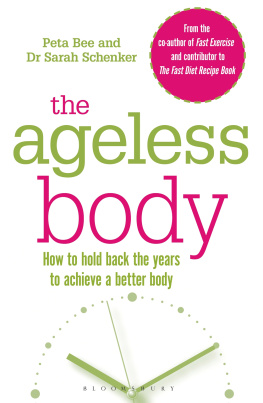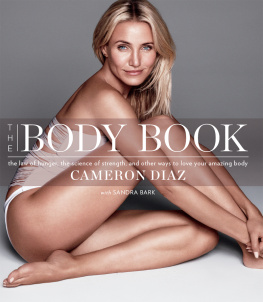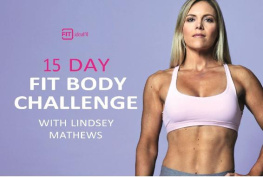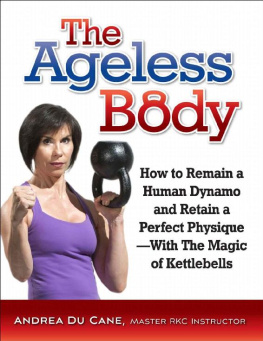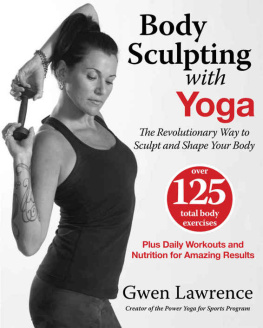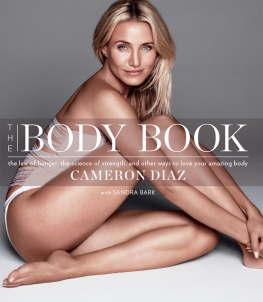The Ageless Body

Contents
My ass is definitely higher than it was when I was 20. This is the thing that people dont understand take care of your body [and it will] get better! It gets better as I get older.
Cameron Diaz
As I write this my 47th birthday is looming. Im edging ever closer to the half-century milestone beyond which women once tipped into a matronly state of old age. Photographs of my grandmothers, who reached their fifties in the 1950s and 1960s, reveal attractive women who had all but given up hope of feeling glamorous again. The waspish waists and coiffed hair of their formative years had given way to thickened middles and a stouter profile; they looked, dressed and behaved old. They adopted a uniform of flat Hush Puppies shoes and Crimplene dresses, a ritual of weekly sets and perms and then got on with it, knowing that society expected no more, no less of them. They withered into female oblivion.
What strikes me when I flick through my family albums is how starkly their perception of ageing and what it should entail, and their willingness to accept and get on with it, differs from how I see myself as a woman of a similar age today. I belong to a generation of 40-, 50- and 60-year-olds who have experienced a seismic shift in attitudes to ageing. A remarkable phenomenon has taken hold: we dont fear getting older, we relish being wiser and more comfortable with who we are and how we feel. A poll of 2000 women revealed the fifties as being the most sex-confident decade of a womans life ]. We look better and feel better than women of our vintage ever did previously.
Dont get me wrong, this new guard of the 40-plus female is not hanging on to youth in desperation. We dont want to be 20 again, neither do we want to live forever. That longing went out with the 1990s, when diets and workouts were about extolling youth, not preserving it. Gone, too, are the chiselled, over-worked midlife bodies that we saw a decade ago, replaced instead by more delicate muscle definition and limbs that are less scrawny, but leaner and lengthier than they appeared even in their twenties.
This emerging breed of mature woman is redefining expectations of the midlife body and proving that seemingly impossible goals are there for the taking. We have our own set of goals, our own set of role models each flaunting exquisite figures that are barely distinguishable from their 30-year-old selves. From Gwen Stefani and Cameron Diaz to Jennifer Aniston and Dame Helen Mirren, they are redefining not just what a midlife body looks like, but whats entailed in achieving it.
Their message is clear: while getting older is inevitable, wallowing in the slowing metabolism and decreased muscle tone it brings is no longer accepted. And with the right approach, you may just be able to hit the pause button. What matters is how you go about defying the years. And the rules have changed. In The Ageless Body , our job is to set about redefining them.
WHATS CHANGED?
This is not a book about turning back the clock or about anti-ageing as weve come to accept the meaning of the term via Botox and fillers, stretching and injecting. Not that we are against such procedures, but we believe there are more fulfilling ways to hit the pause button. Neither, for that matter, is it about clinging on to youth in desperation. If you feel the need to starve yourself of carbs, to schedule in five Spinning sessions a week and back-to-back yoga classes alongside training for your first triathlon, it really is not the thing you should be reading.
A dramatic shift in expectations means that, despite being plagued by the slowing metabolism that afflicts all pre- and post-menopausal women, we can realistically aim for a flat stomach and sculpted arms. Diet and exercise neednt leave you looking as ropey and sinewy as the over-worked Sarah Jessica Parker, but it can leave you effortlessly toned, embodying the kind of appearance we all took for granted in our thirties. We can eat without gaining weight (hooray), consume carbs without them heading straight for the stomach and hips. But we need to recalibrate and re-set our systems in order to achieve an Ageless Body and relish the benefits it brings.
In the course of writing this book, Sarah and I have rifled through endless scientific papers, and tapped the worlds leading academic ageing experts for insights into what we can do to decelerate the rate at which we look and feel older. We have also used ourselves as guinea pigs. Both in our forties (me towards the top of the age group, Sarah a relative newbie to the decade), we have children, demanding jobs, hectic social lives and little time to devote to much else. In theory, we didnt have time to overhaul our lifestyles, but we made it and the results have been transformational in many ways.
So what have we discovered? In a nutshell, many of the rules you thought held true for diet and exercise are irrelevant from this age onward. We know from our investigations and the emerging science that standard diet and activity advice simply doesnt work from your mid-thirties onwards. Whats required is a radical alternative, an approach that has the potential to change the way you eat and exercise forever.
What can you expect? Workouts will be shorter and harder. Endless aerobic activities that were the gym fixation of the last three decades are unnecessary for maintaining and improving fitness as you get older. Indeed, throwing yourself into repetitive marathons and triathlons after 40 is now considered the ageing equivalent of sunbathing. Hugely effective in terms of fat loss, these long, pounding activities can leave you drawn and haggard.
Too much endurance slogging stresses the skin in a way that causes wear and tear and leads to a drop in its youthful plumpness. You still need it but in shorter bursts. Up to 45 minutes of jogging, cycling or fast walking three times a week and not going at breakneck speed could be enough. Scientists at McMaster University in Canada reported that this kind of approach was enough to boost skin plumpness in the outer and inner layers of a group of volunteers aged 65 and older. After three months, the complexion of the exercisers resembled what the scientists said theyd typically expect to find in healthy 2040-year-olds [].
Youll need to work harder for a shorter time to get results and we introduce the principles of High Intensity Interval Training (or HIIT): it minimizes the amount of pounding (not good for vulnerable tendons and knees either) but works the heart and boosts metabolism (strictly necessary: it plummets by as much as 25 per cent as we age). And strength training becomes essential. Theres little doubt we need it post-35 when muscle begins diminishing at a rate of 1lb (0.5kg) a year leaving you with sag and sinew unless you address it. As someone whod always feared weights, I am a convert and a firm one (in every way). In fact, none of the workout methods should scare you: be prepared to be won over from the first week.
Your diet will also come under scrutiny. You will be eating less of the foods that detract from healthful vibrancy, more of the stuff that helps to maintain it for longer than women have in the past. Calories will be considerably lower than is recommended for women of our age; snacks are out and the benefits of breakfast are questioned. But we promise you wont go hungry. Whats more, you will be brimful of energy, your skin will glow and you will not only look healthier, but feel better from within.
I have absolutely no objection to growing older. I am a stroke survivor so I am extremely grateful to be ageing I have nothing but gratitude for the passing years. I am ageing lucky, lucky me!

